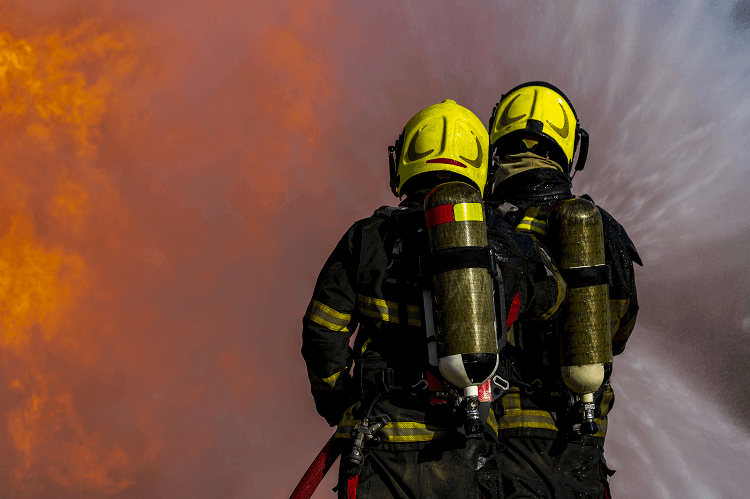You have a duty of care to your employees, which means you’re required to take all necessary precautions regarding their health & safety.
However, it’s not always possible to eliminate all risks in the workplace. So, when an incident does happen, you’re required by law to report it.
In this article, we will cover the different types of near misses and incidents that can happen at work, as well as guidelines for an incident reporting system.
Incidents vs Accidents
Incidents and accidents are terms that are often used interchangeably. But they shouldn't be, as each one has its own definition.
An incident refers to an unplanned event that doesn’t lead to a personal injury. However, it could lead to the property being damaged. An accident refers to an unplanned event that does lead to a personal injury or damage to property.

What is a major incident?
A major incident is a significant event that needs a response outside of the normal routine. A major incident requires a response from an emergency service and can be either natural or human-made.
Causes include:
- Accidents (road, rail, air or water).
- Terrorist acts.
- Heatwaves and other severe weather.
- Oil Pollution
- Building collapse.
What is a reportable incident?
The Health & Safety Executive (HSE) enforces regulations for reporting incidents at work. The Reporting of Injuries, Diseases and Dangerous Occurrences Regulations 2013 (RIDDOR) puts the duty of covering serious workplace injuries on you. Its list of reportable injuries includes:
Deaths
Any incidents that result in fatal or major injuries need to be reported through national reporting systems. It's important to remember that this isn't limited to work-related serious incidents, they include injuries caused by physical violence. Suicides or sudden deaths by natural causes don't need to be reported under RIDDOR.
Occupational diseases
You must make an incident report for occupational diseases found in your workplace. These could be due to a dangerous substance or biological agent that's used during certain types of work. Incident reports might include injuries, such as
- Reduced mobility/function.
- Carpal Tunnel Syndrome
Gas incidents
Gas incidents are a common occurrence, and harmful substance or pressure system incidents should be reported to the HSE. You should also put in place a successful incident reporting system. This will allow you to mitigate the incident from happening again or prevent it from becoming more fatal.
Dangerous occurrences
Dangerous occurrences need to be reported. In some cases, they can cause severe injury or be fatal.
A dangerous occurrence could include general incidents that happen in the workplace. For example, these could include clinical risk management if the breathing apparatus gets broken, or the load-bearing part of a piece of machinery breaks.
Equally, it could include incidents that occur in places that aren't in offshore workplaces. Or incidents that take place in specific workplaces like offshore facilities, mines and some transport systems.
What is a near-miss incident?
A near-miss incident doesn’t result in injury or damage but has the potential to do so.
These incidents still need to be reported, as they can help determine why the issue occurred in the first instance. They also help employers prevent it from happening in the future while helping to improve incident reporting.

What is a critical incident?
A critical incident is an incident that can overwhelm a person or group of people. The incidents are often traumatic.
This also includes when an employee experiences a strong emotional response to a traumatic event. When events like this take place, employers can benefit from the intervention of CISM (Critical incident stress management) to help members of the team cope with the aftermath of the event.
Examples of critical incident reporting can include:
- Witnessing a mass casualty.
- Losing a co-worker to suicide.
- Situations where the employee's life is in peril.
- Losing someone or a patient that you're trying to save.
- Being part of an event that is covered widely in the media.
For example, within a workplace, a critical incident is one that disrupts an employee's ability to work. It could also be when they're affected by the death or injury of a colleague because of a traumatic event.
What is critical incident stress?
If an employee experiences trauma or a traumatic incident, they can have a strong emotional reaction. Implementing CISM is the best way of helping your employees through the situation.
Stress because of the incident can present itself differently in different people and can present itself in physical, mental, and emotional ways.
An example of this is stress. It can show itself in different forms, such as:
- Reduced attention span.
- Disturbed sleep.
- Emotional outburst.
- Difficulty relaxing.
- Feeling uncertain or fearful.
- Changes in appetite.
- Wanting to socialise less.
Not all your employees will react in the same way, and in some cases, they won't react straight away.
Introducing CISM can help to improve the situation. It provides your staff with an experienced trauma counsellor for confidential one-to-one conversations. In turn, that can help to improve the psychological, physiological, and emotional issues an employee may be experiencing.
What does Critical stress management involve?
There are different ways that critical street management can be integrated into a business after a traumatic event. All should be considered when putting together your critical incident reporting system.
Each one is designed to benefit your employees and help them through difficult situations. You could include some of the following.
Crisis management briefing
Crisis management briefings are informational events. They can contain valuable information that you can use to help your employees tackle stress and provide resources.
Within these briefings, you should be able to address any falsehoods or rumours that have arisen following an adverse event.
These briefings can take place in the workplace, at schools, in communities and in religious organisations.
Critical incident stress debrief (CISD)
These meetings can help employees process the traumatic and critical incidents they witnessed or were affected by. CISD normally take place within 72 hours of the incident and can be used to identify employees who may need additional support.
Rest information transition service (RITS)
RITS is a support service that may be set up close to where the incident took place.
If needed these centres can offer food, shelter, accommodation and the necessary supplies.
Individual support
Depending on the employee and the incident, employees may need individual support. Whether this is through peer support or basic counselling from a crisis team.
You can also use this to identify where more support is needed, for example, if an employee needs extra mental health support.

What is the purpose of incident reports?
Reporting incidents is a legal requirement. Submitting these reports to the national incident reporting systems, means occupational health authorities are able to identify where and how risks arise in organisations.
Through incident reporting, employers and organisations can put together preventative measures to stop the incident from happening again.
Setting up an effective critical incident reporting system
When you're putting together your incident reporting system, you should ensure that you're complying with RIDDOR. This will help you with risk management and help preventable adverse events.
What's RIDDOR?
RIDDOR stands for Reporting of Injuries, Diseases and Dangerous Occurrences Regulations.
Your RIDDOR policy should outline the methods of managing risks and reporting critical incidents and accidents. This should also include who the policy relates to. For example, who it is an employee needs to report incidents to.
Employers must remember that any major injury or incident should be reported to the HSE in compliance with the Reporting of Injuries, Diseases and Dangerous Occurrences Regulations 2013.
When implementing effective reporting systems, you should ensure that your reports are submitted under one of the following categories:
- Report of injury.
- Report of a dangerous occurrence.
- Report a case of disease.
- Report of a flammable gas incident.
- Report of a dangerous gas fitting.
- Report of an injury offshore.
- Report of a dangerous occurrence offshore.
Successfully implemented incident reporting systems will help businesses to mitigate the risks of the incidents happening again. These reports can be potentially valuable national resources to help other businesses with their risk management.
Writing the incident reports
When it comes to employee health and safety, the employer is responsible for everyone in the workplace. As such they or their responsible person, are responsible for writing incident reports when they happen.
Completing an Incident Reporting Systems Investigation can help identify the cause of the incident if it isn't clearly identifiable, and potentially reduce the risk of repeating similar incidents.
The incident report system should include:
- The date the incident happened, and the method for incident reporting.
- When and where the incident happened.
- Personal details of everyone involved.
- A description of injuries, diseases and dangerous occurrences.
The responsible person who is completing the incident reporting needs to submit the report to the HSE within the appropriate time limit - normally within 10 days.

Need our help?
Croner has a team of award-winning HR consultants who are specialists in their field. We've been helping businesses for over 80 years and our advice line is open 365 days a year, 24 hours a day.
If you need support in incident reporting or help in putting together a reporting system get in touch with one of our experts today at 0800 470 2805.
Related resources
Categories
- Business Advice
- Culture & Performance
- Disciplinary & Grievances
- Dismissals & Conduct
- Employee Conduct
- Employment Contracts and Documentation
- Employment Law
- Employment Rights Bill
- End of Contract
- Equality & Discrimination
- Health & Safety
- Hiring and Managing
- Leave & Absence
- Managing Health & Safety
- Moving
- Occupational Health
- Pay & Benefits
- Recruitment
- Risk & Welfare




